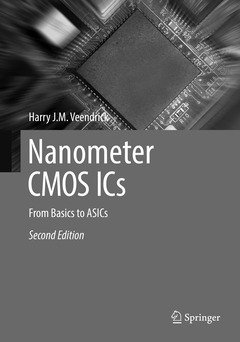Description
Nanometer CMOS ICs (2nd Ed., Softcover reprint of the original 2nd ed. 2017)
From Basics to ASICs
Language: English
Subject for Nanometer CMOS ICs:
Nanometer CMOS ICs
Publication date: 09-2018
Support: Print on demand
Publication date: 09-2018
Support: Print on demand
Nanometer CMOS ICs
Publication date: 05-2017
Support: Print on demand
Publication date: 05-2017
Support: Print on demand
Description
/li>Contents
/li>Biography
/li>Comment
/li>
This textbook provides a comprehensive, fully-updated introduction to the essentials of nanometer CMOS integrated circuits. It includes aspects of scaling to even beyond 12nm CMOS technologies and designs. It clearly describes the fundamental CMOS operating principles and presents substantial insight into the various aspects of design implementation and application. Coverage includes all associated disciplines of nanometer CMOS ICs, including physics, lithography, technology, design, memories, VLSI, power consumption, variability, reliability and signal integrity, testing, yield, failure analysis, packaging, scaling trends and road blocks. The text is based upon in-house Philips, NXP Semiconductors, Applied Materials, ASML, IMEC, ST-Ericsson, TSMC, etc., courseware, which, to date, has been completed by more than 4500 engineers working in a large variety of related disciplines: architecture, design, test, fabrication process, packaging, failure analysis and software.
Basic Principles.- Geometrical-, Physical- and Field-Scaling Impact on MOS Transistor Behavior.- Manufacture of MOS Devices.- CMOS Circuits.- Special Circuits, Devices and Technologies.- Memories.- Very Large Scale Integration (VLSI) and ASICs.- Low Power, a Hot Topic in IC Design.- Robustness of Nanometer CMOS Designs: Signal Integrity, Variability and Reliability.- Testing, Yield, Packaging, Debug and Failure Analysis.- Effects of Scaling on MOS IC Design and Consequences for the Roadmap.
Harry Veendrick graduated from the Technical University Eindhoven, the Netherlands, in 1977. In the same year he joined Philips Research Laboratories, also in Eindhoven, where he has been involved in the design of memories, gate arrays and complex digital video-signal processors. He holds 30 US and many more European patents in the area of CMOS circuit design, with several other patents pending, and he is the (co-)author of more than 30 publications on robust, high-performance and low-power CMOS IC design. In this respect, he has contributed to many conferences and conference workshops, as reviewer, speaker, invited speaker, panellist, organizer, guest editor and program committee member. In addition, he is the author of MOS ICs (VCH 1992), Deep-Submicron CMOS ICs, from Basics to ASICs (Kluwer Academic Publishers: 1-st edition 1998, 2-nd edition 2000) and Nanometer CMOS ICs, from Basics to ASICs (Springer: 1-st edition June 2008). He is a co-author of Low-Power Electronics Design (CRCPress, 2004). His principle research interests included the design of low-power and high-speed complex digital CMOS circuits, with an emphasis on nanometer-scale physical effects and scaling aspects. From 2002 to 2009 he has been project leader of the Deep-Submicron/Nanometer CMOS Electrical Design Cluster within the research group Mixed-Signal Circuits and Systems at NXP Research, which is the 2006 spin-off of the disentangled former Philips Semiconductors Product and R&D Departments. Complementary to this is his interest in IC technology, which allows him to act as an interface between digital IC design and IC process technology. From 1980 onwards, next to his research activities, he has been actively involved in the training of more than 4500 semiconductor design, test, product, CAD tools and process engineers. In 2002 he received the PhD degree in electronic engineering from the Technical University of Eindhoven, The Netherlands. He was a Research Fellow at Philips Research Laborat
Provides semester-length textbook, with comprehensive coverage of nanometer CMOS integrated circuits Covers all associated disciplines of nanometer CMOS ICs, including physics, design, process, yield, packaging, power, variability, reliability and signal integrity, test and packaging Enables readers to gain understanding of the complete development chain, from physics to applications Includes in-depth exercises for each chapter
© 2024 LAVOISIER S.A.S.




